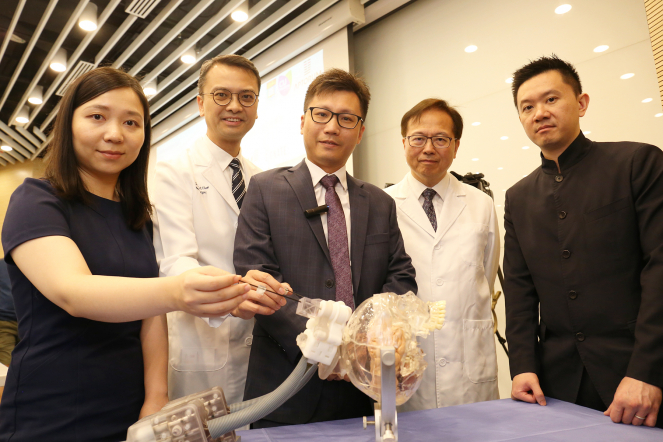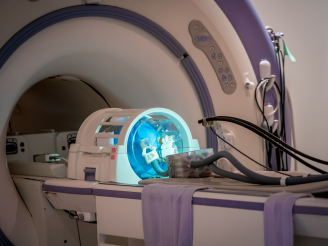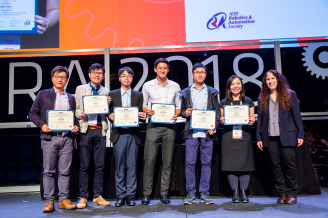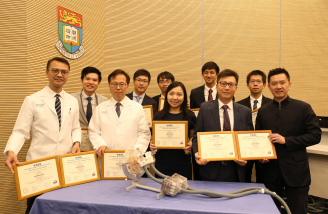Media
World’s first intra-operative MRI-guided robot for bilateral stereotactic neurosurgery
13 Jun 2018
Stereotactic neurosurgery is one of the treatment to a variety of movement and neuropsychiatric disorders, such as Parkinson’s disease (PD), essential tremor and major depression. It involves a technique that can locate targets of surgical interest using an external positioning system, which is widely applied in brain biopsy, tumor ablation, drug delivery, as well as deep brain stimulation (“DBS”). Parkinson’s disease alone is the second most common disease of the nervous system after Alzheimer’s disease, and is projected to affect over 8.7 million people worldwide by 2030. As such, any improvement to this surgery would benefit a large population.
A HKU Mechanical Engineering team led by Dr. Kwok Ka-wai recently designed the first neurosurgical robotic system capable of performing bilateral stereotactic neurosurgery inside a magnetic resonance imaging (“MRI”) scanner. The team also conducted pre-clinical validation of the system with CUHK neurosurgeons, Dr Danny Chan Tat-ming and Professor Poon Wai-sang. This innovative technological breakthrough can facilitate the treatment of Parkinson’s disease and other neuropsychiatric disorders.
DBS therapy, like a heart pacemaker, can deliver electrical signals through implanted electrodes to the deep brain targets. It helps to restore normal nerve cell activity. This surgery is tremendously demanding on accuracy, by targeting only the tiny nucleus structures and not damaging the surrounding critical tissue. Without the intra-operative updates of a surgical “roadmap”, the brain may shift after the skull is opened and inevitably lowers the targeting accuracy. Conventional DBS is performed while the patient is awake under local anesthesia. Surgeons have to rely on verbal or physical interactions with the patients to ensure the electrode placement is going well. These surgical complications motivated the HKU-led team to develop a compact robot guided by MRI. This facilitates less invasive stereotactic procedures on the patient under general anesthesia, as surgeons could accurately control and evaluate the stereotactic manipulation bilaterally to the left and right brain targets in real time.
The team successfully resolved many unmet technical challenges. For example, MRI scanners have very strong magnetic fields and most metallic components are forbidden in MRI environments, including the electromagnetic (EM) motors commonly used in robots. The team has developed a totally magnetic resonance (“MR”) compatible tele-operated system driven by liquid. It does not generate any EM interference or affect imaging quality even during the robot operation. A manipulator is designed to perform dexterous operation towards the left-and-right brain targets, and the area required for an invasive anchorage is very small. The compact robot design can be accommodated inside a standard MRI head coil for imaging and intervention. Advanced 3-D tracking markers are also developed, which enable fast localization of robot instruments in MRI in real time.
The success of this project would represent a major step towards safer, more accurate and effective brain surgery. It is believed that all these components can be applied to other interventions requiring MRI guidance, e.g. cardiac catheterization, prostate or breast biopsy. The research team plans to conduct further clinical studies to determine the efficacy of the system.
The team comprising both engineers and surgeons was recently conferred the Best Conference Paper Award in the largest international forum for robotics scientists, the IEEE International Conference on Robotics and Automation 2018 (ICRA’18), which was held in Brisbane, Australia, from May 21 to 25, 2018. The ICRA is the world’s top conference where robotics scientists can introduce and present their latest work. More than 3,000 participants from academia and industry join the conference annually. This year, ICRA’18 reviewed 2,539 papers, a new record in its history, from 61 countries. A total of 1,030 papers were selected for presentation.
This year, the team was conferred the final best out of 35 finalists in all the nine robotics categories, including robot vision, cognitive robotics, robot manipulation and unmanned aerial vehicles. Other shortlisted universities and companies include MIT, Harvard, Stanford and DeepMind. The team project was also shortlisted as a finalist for the Medical Robotics paper award at the same Conference.
For more details about this innovation, please click: https://ieeexplore.ieee.org/document/8310892/ for the academic paper “Compact Design of a Hydraulic Driving Robot for Intraoperative MRI-Guided Bilateral Stereotactic Neurosurgery” published earlier in IEEE Robotics and Automation Letters.
For the powerpoint slides on this research, please click here.
For the photos on this research, please click here.
Spokespersons:
Dr. Kwok Ka-wai, Assistant Professor, Department of Mechanical Engineering, Faculty of Engineering, HKU
Ms. Guo Ziyan, PhD Candidate, Department of Mechanical Engineering, Faculty of Engineering, HKU
Dr. Danny Chan Tat-ming, Division of Neurosurgery, Department of Surgery, CUHK
Professor Poon Wai-sang, Division of Neurosurgery, Department of Surgery, CUHK
Mr. Ian Huen Chung-yuen, Founder, Chief Executive Officer and Executive Director, Aptorum Group Limited
Media enquiry:
Faculty of Engineering
Dr. Peggy Leung (Tel: 2219-4492; Email: peggypeg@hku.hk)
Ms Rhea Leung (Tel: 3917-8519/ 9022-7446; Email: rhea.leung@hku.hk)
Communication and Public Affairs Office
Ms Trinni Choy (Tel: 2859 2606; Email: pychoy@hku.hk)
Ms Rashida Suffiad (Tel: 2857 8555; email: rsuffiad@hku.hk)




